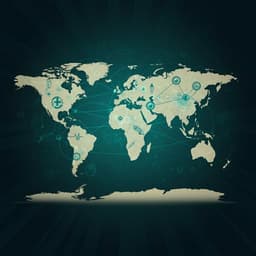
Environmental Studies and Forestry
Self-supplied drinking water in low- and middle-income countries in the Asia-Pacific
T. Foster, C. Priadi, et al.
This study by Tim Foster, Cindy Priadi, Krishna Kumar Kotra, Mitsunori Odagiri, Emily Christensen Rand, and Juliet Willetts reveals that over 760 million people in the Asia-Pacific region rely on self-supplied drinking water, with rural areas being more dependent than urban areas. The dominance of groundwater in South and Southeast Asia, along with rainwater collection in the Pacific, underscores the importance of self-supply in shaping water policies and financing strategies.
~3 min • Beginner • English
Introduction
Household self-supply refers to privately owned, financed, and managed water sources such as wells, boreholes, or rainwater collection systems. While an emerging body of literature has focused on self-supply in sub-Saharan Africa, it has been relatively unexamined in Asia and the Pacific despite evidence that private water sources are common in some countries. In LMICs in the Asia-Pacific, 93% of households used an improved drinking water source in 2017 but only 37% used a piped source, suggesting substantial potential for self-supply. Self-supply occurs in diverse contexts—from dense cities with piped systems to unplanned urban areas, rural settings alongside communal sources, and remote areas lacking public supplies. It may be a luxury for wealthier households or an option of last resort for poorer ones, and may serve as primary drinking water or for other domestic needs. Motivations include perceived safety, reliability, taste/odor, convenience, and cost. Policy and finance implications are significant: self-supply is often overlooked by regulation and monitoring, and household investments are poorly tracked, potentially leading to inefficiencies across the sector. Public health implications are critical, as self-supply sources often fall outside routine water quality testing, affecting interpretations of progress toward SDG 6.1 (safely managed drinking water). To understand prominence and policy implications in LMICs in the Asia-Pacific, this study aimed to (i) estimate the prevalence of self-supply in 2018, (ii) characterize types of self-supply practiced, and (iii) describe adoption trends, using 77 national datasets from 26 LMICs across Southeast Asia, South Asia, and the Pacific.
Literature Review
The paper highlights an emerging literature on household self-supply, which has been more extensively documented in sub-Saharan Africa’s urban and rural settings. Evidence indicates private sources are common in several Asia-Pacific countries. Prior studies discuss the coexistence of self-supply with municipal systems, its use in unserved urban areas and rural contexts, and its role as either a complement or substitute for public services, with households often using multiple sources seasonally or for different purposes. Literature points to mixed socio-economic drivers—self-supply may be a luxury for wealthier households or a necessity for poorer ones—and varied motivations (safety, reliability, cost, convenience). Policy-oriented literature notes that self-supply is often under-recognized by governments, with a few exceptions, and that household investments are largely invisible in sector finance tracking (e.g., GLAAS reporting, with Bangladesh a notable exception). Public health literature raises concerns about water quality risks in self-supplied sources (microbial and chemical contamination), particularly in densely populated urban settings with onsite sanitation and in rainwater systems that may lack adequate protection. There are calls for integrating water quality testing into national surveys (e.g., MICS) to better assess safety relative to SDG 6.1 criteria.
Methodology
Design: Secondary analysis of nationally representative datasets and national censuses for LMICs in South Asia, Southeast Asia, and Oceania (Asia-Pacific), classified using World Bank income groups. Data sources: 77 datasets from 26 LMICs identified via WHO/UNICEF JMP country files and obtained from DHS, MICS, national statistics agencies, and the Pacific Community (SPC) repositories. Inclusion criteria: Datasets reporting household water sources with either ownership status or location relative to premises. Definition of self-supply: Groundwater (borehole/tubewell; protected/unprotected well) or rainwater sources that were (a) located on the respondent’s premises or (b) denoted as private/household-owned per source category/notes. Categorization: Self-supply sources aligned to JMP categories: borehole/tubewell, protected well, unprotected well, rainwater collection. Analysis: Conducted in SPSS v26 with sample weights. Prevalence computed as the proportion of population using self-supply as main drinking water source, at country and regional levels (Pacific, Southeast Asia, South Asia), disaggregated by urban/rural where possible. Additional analyses included source type distributions, seasonal differences (wet vs dry where available), and non-drinking uses among households whose main drinking source was bottled water. Handling data gaps: For countries lacking clear on/off-premises or private/communal delineation (e.g., Solomon Islands, Vanuatu, Fiji, Marshall Islands, Tonga for groundwater; Sri Lanka for rainwater), on/off-premises ratios were inferred from earlier national datasets or neighboring countries (details in Supplementary Information). Estimation methods: Method 1 (crude) used most recent dataset prevalence applied to 2018 population to estimate users; regional prevalence calculated from summed users over regional populations. Method 2 (adjusted) fitted best-fit regression lines to multiple data points (post-2000) separately for urban/rural to estimate 2018 prevalence, applied to 2018 populations; where regression not feasible (six countries), used most recent prevalence. Method 2 is considered more robust; Method 1 allows broader coverage and source-type disaggregation. Coverage: Relevant data were found for 26 countries representing 98.7% of the population of all LMICs in the Pacific, Southeast Asia, and South Asia. Data availability: Datasets available from DHS, MICS, Pacific Data Hub, JMP, and national statistics portals (listed in Supplementary Information).
Key Findings
- Scale and prevalence: Approximately 32% of the population (~780 million people) in LMICs of the Asia-Pacific used self-supply as their main drinking water source in 2018 based on crude estimates; adjusted for temporal trends, prevalence was 31%, equivalent to ~760 million people, with ~9.4 million additional users each year (2 million urban, 7.4 million rural).
- Urban–rural differences: Self-supply is more common in rural areas than urban (crude: 38% rural vs 21% urban; adjusted: 37% rural vs 20% urban). This pattern holds in South Asia and Southeast Asia but is reversed in the Pacific (about 14–15% rural vs 17% urban).
- Regional variation: South Asia shows the highest reliance (crude ~33%; adjusted ~32%), Southeast Asia ~29% (crude; adjusted 28%), and Pacific ~15% (both crude and adjusted). Excluding India increases South Asia prevalence from 33% to 50%; excluding Papua New Guinea increases the Pacific estimate from 15% to 17% (crude context).
- Country variation: Self-supply is ubiquitous in Bangladesh (about 71%) and Marshall Islands (~79% crude; adjusted 77%), low in Bhutan (~0%) and Fiji (~4%). India, Bangladesh, Pakistan, and Indonesia account for ~85% of all self-supply users in the study.
- Source types: Tubewells/boreholes are the most common self-supply source across the region (nearly a quarter of the total population), driven by South Asia. Southeast Asia shows a more even distribution among boreholes/tubewells (~12%), protected wells (~9%), and rainwater (~5%). In the Pacific, self-supply is predominantly private rainwater tanks. Among self-supply users, 95% rely on JMP-defined improved sources.
- Bottled water interplay: In six Southeast Asian countries with data, considering households that use bottled water for drinking but self-supply for non-drinking increases self-supply reliance from ~30% to ~45% (≈+70 million people). Example: In urban Indonesia, 28% self-supply for drinking (~41 million), plus an additional 29% use self-supply for non-drinking (~43 million).
- Seasonality: Cambodia’s data show strong seasonality—self-supply as main drinking source increases in the wet season (overall 61% wet vs 36% dry; rural 68% vs 41%; urban 20% vs 13%), largely due to increased rainwater collection.
- Temporal trends: Absolute numbers relying on self-supply are rising, but the proportion of the population is relatively stable overall, reflecting increasing rural shares and decreasing urban shares. Countries with notable increases (>0.5 percentage points/year) include Bangladesh, Cambodia, Nepal, and Vanuatu; notable declines (~1 percentage point/year) include Thailand, Tonga, Vietnam, and Indonesia.
Discussion
The study demonstrates that self-supply is extensive across the Asia-Pacific, with roughly one in three people relying on private sources for drinking water, and numbers growing annually. The prominence of self-supply indicates households are key, yet often invisible, financiers of water infrastructure. Policy responses must balance opportunities and risks: self-supply mobilizes additional funding, can be managed at the household scale, and reflects agency in development. However, it is difficult to monitor and regulate, may undermine economies of scale from pooled investments, complicates groundwater governance, and presents water quality risks. SDG 6.1 implications are significant: while on-premises access aligns with safely managed criteria, less is known about contamination risks and reliability compared with centralized systems. Many urban self-supply users fall outside utility water quality monitoring, necessitating integration of water testing into household surveys to better estimate the ‘free from contamination’ criterion. Climate change may disproportionately affect self-supplying households, especially those with shallow wells or small rainwater tanks, potentially exacerbating inequalities. Equity considerations are critical: who benefits from self-supply, and whether poorer households rely on higher-risk forms, remains unclear. Sharing of private sources with neighbors and use of self-supply as secondary sources are likely underrepresented, meaning true dependence is higher than estimated. Experiences from other regions (Africa, the Americas, Middle East, high-income countries) suggest opportunities for supportive policy frameworks to enhance beneficial self-supply and mitigate detrimental forms.
Conclusion
Self-supply of drinking water is widespread and growing across LMICs in the Asia-Pacific, with households providing a substantial share of investments in water supply. This reality presents both opportunities—additional financing, household-scale management, and resilience benefits—and risks—monitoring and regulatory challenges, potential inefficiencies, groundwater management issues, and water quality concerns. Policymakers should consider strategies that recognize and harness household investments while ensuring safety and sustainability, including improved data collection on household expenditures, integration of water quality testing into major surveys, and targeted support where self-supply is prevalent. Future research should quantify costs and benefits of self-supply, identify the socio-economic and environmental drivers of adoption, assess equity implications, evaluate climate resilience, and test policy interventions to maximize benefits and minimize risks.
Limitations
- Data constraints and underestimation: National surveys and censuses generally capture only the main drinking water source, limiting the ability to account for self-supply as a secondary source or shared private sources; true dependence is likely higher. Non-drinking uses of self-supply could only be examined where surveys asked secondary-source questions for bottled-water users.
- Classification gaps: Some countries lacked clear delineation between on/off-premises or private/communal sources (e.g., groundwater in Solomon Islands, Vanuatu, Fiji, Marshall Islands, Tonga; rainwater in Sri Lanka). Ratios were inferred from earlier datasets or neighboring countries, introducing uncertainty.
- Temporal trend coverage: Trend analyses were possible for 20 of 26 countries; for six countries, the most recent prevalence was used in adjusted estimates, potentially affecting robustness.
- Source-type omissions: Data constraints prevented inclusion of groundwater-based self-supply for Tonga and Marshall Islands and rainwater-based self-supply for Sri Lanka in some estimates.
- Water quality not assessed: The study does not directly measure water quality or availability, limiting conclusions about ‘safely managed’ status under SDG 6.1.
- Assumptions in financing estimates: Illustrative estimates of household investment rely on assumed unit costs and full household funding, which may not always hold.
- Generalizability to non-LMIC or excluded LMIC contexts: One Southeast Asian LMIC (Malaysia) lacked suitable data; findings pertain to the 26 countries analyzed, though they cover 98.7% of the regional LMIC population.
Related Publications
Explore these studies to deepen your understanding of the subject.







